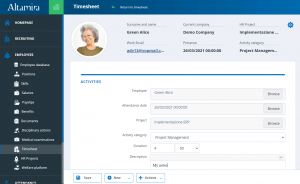Social recruiting is now a well-established reality all over the world.
Despite this fact, social networks keep being underestimated as a working tool.
This happens in marketing, where the role of social media manager is often entrusted to junior figures or to those without specific skills. But it also happens in the HR world, where it is still rare to see investments in training and organization for social recruiting.
However, social networks can offer excellent results if they are used methodically.
Here are 3 suggestions to start from.
Establish a policy
Social networks have become an important tool for recruiters, due to the fact that the millions of people who use them tend to share a large quantity of information and opinions, without the filter they would put up in other contexts.
However, it is precisely this abundance of data that should lead companies and recruiting firms to establish a well-defined policy on which types of information should be taken into account when evaluating a candidate, and which shouldn’t.
Otherwise, the risk is that recruiters will proceed in a disorganized manner, awarding more or less value to each data point and being influenced by their own opinions and beliefs.
A social recruiting policy should clarify for what purposes the social media profile of a candidate should be analyzed, and what types of content are and are not relevant.
Verifying the consistency of the information a candidate has shared on social media with the CV they submitted is an activity that would certainly provide added value, while—for example—no weight should be given to political and religious opinions, unless they contain serious elements of discrimination. Similarly, the quality of the network developed by the candidate on LinkedIn can be assessed in an objective manner, while Facebook friendships are a much less reliable criterion.
In order to avoid situations in which prejudice would influence the choice of a candidate, in the most well-organized companies, the person in charge of social media screening is not the same as the one in charge of the selection process, who simply receives a summarizing report from the former.
Use social media channels also for internal recruitment
Companies used to employ a physical bulletin board at the office to let employees know about new positions that were open at the company.
Today, beside making use of the functionality of their ATS, employers can also use internal social media channels for this purpose.
The most important aspect is publishing the open positions in a virtual place that is frequented by employees.
Here are some examples:
- the virtual bulletin board of your employee portal
- the internal chat channel, whether this is on Slack, Microsoft Teams, WhatsApp, etc.
- the private Facebook group
In order to achieve the maximum level of response, job offers should be shared several times over a certain period, using images and videos to attract more attention from colleagues.
Internal recruiting is a tool that has always been used by companies, since it provides a whole series of advantages that are further enhanced by social media:
- It is a free source of CVs.
- It is able to engage passive candidates (those who are not actively seeking a new position).
- It provides more information on candidates.
- In turn, the candidates will arrive at the interviews more prepared and already familiar with the company’s culture and climate.
Integrate social recruiting into the candidate selection strategy
To be truly efficient, social recruitment should always be integrated into a broader search and selection strategy.
Relying solely on social networks has a number of disadvantages:
- The data collected remains the property of the social networks that have provided it.
- This seriously narrows the pool of available candidates.
- Even when you successfully complete a selection process, you cannot be sure that you have used the most appropriate channel, as you don’t have any way to compare it with others.
- It is not possible to cultivate a company CV database over time to be used for all future selections.
All these limitations can be solved by adopting an ATS and adding the applications obtained through social media to its CV database.
You will thus obtain a database of candidate profiles that you own, which will include CVs from any channel you’ve used: social media, job board, career site, events, etc.
By comparing the different sources of candidates, you can find out which ones deliver more CVs and which ones guarantee a higher average quality. In this way, you will know, for each position, when it is worth investing time and money into social networks and when it would be better to prioritize other channels.
Copyright: ©Premium Stock/Adobe Stock




























































































